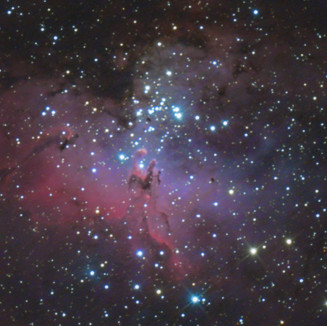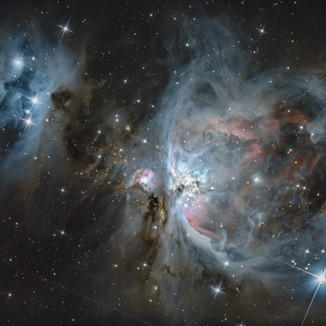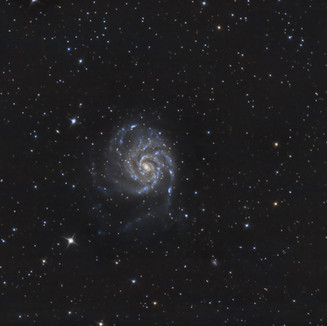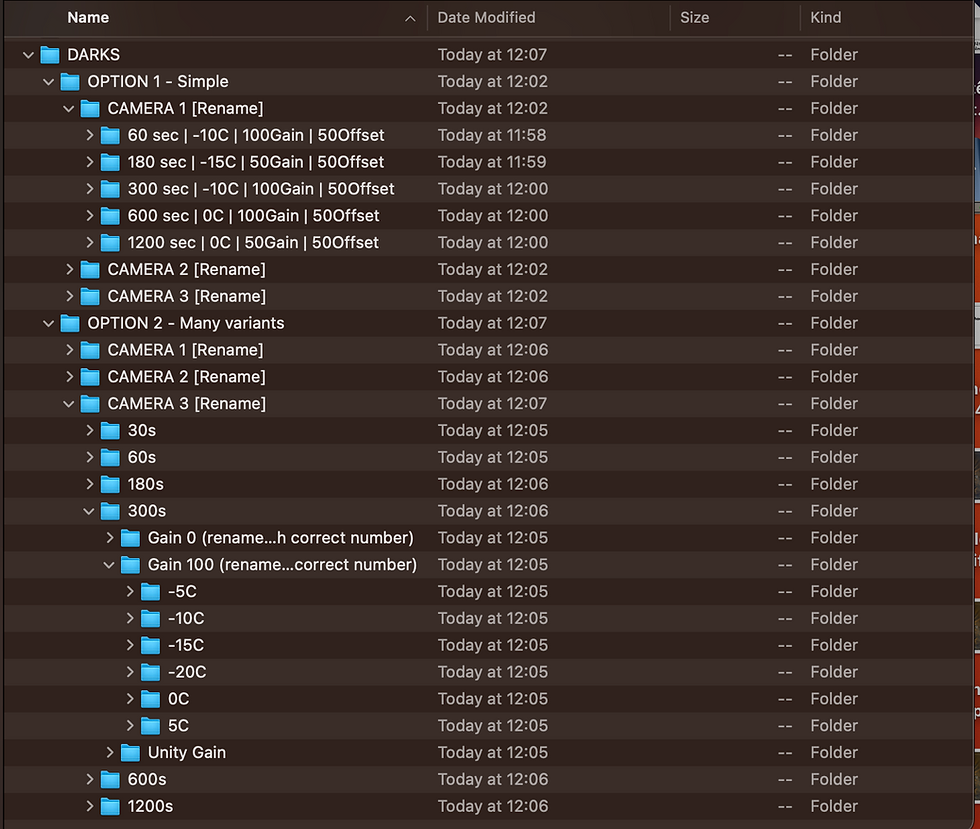Orion 8" Astrograph F/3.9 - Review of Our $479 Telescope
- Antoine & Dalia Grelin

- Nov 2, 2018
- 6 min read
Updated: May 20, 2023
Important Update: This specific telescope can be difficult to find now, and the price went up a lot. Some of the links you will find below will direct you to a different brand, but identical telescope.

The 8" f/3.9 Orion Newtonian Astrograph Reflector Telescope was our very first telescope purchase, and we do not regret it one bit!
To this day, we use the same telescope to capture all the Deep Sky Objects seen in our gallery. A few examples will be attached below as well.
This is our honest, straight-to-the-point review about this affordable telescope. We were not compensated to make this review.
A Fast Focal Ratio Focused on Imaging
At f/3.9, the Orion Astrograph is one of the fastest telescopes you can find that is quite affordable.
But what does that mean? It means that your telescope (as well as your camera) can gather light much faster compared to other instruments that have a higher F number. This is an important feature for astrophotographers, especially those like us who cannot image from our home, because the faster the focal ratio is the less time you need to spend on each target.
However, there is a small downside to this which we will discuss in another section.
Here is an example of 30 seconds on the Orion Nebula. Seeing a great image like that appear on your camera really makes you wonder how spectacular the stacked image will be.
8" - A Perfect Aperture for Beginner Astrophotographers
When we were able to purchase a complete astrophotography setup, we spent a long time trying to decide which size we wanted our telescope to be. The 10" version of this astrograph was an enticing upgrade at only a couple hundred dollars more, but we decided to get the 8" instead.
Our reasoning was that although the 10" would have allowed us to better photograph smaller and fainter objects (including planets), we would have not been able to fit "beginner targets" in our frame unless doing a mosaic. Knowing that we would become more knowledgeable over time, it seemed like the best fit for us to start out with the 8" and get a real handle on what we wanted to accomplish.
This 8" astrograph has a focal length of 800mm, which is perfect for framing large targets like M31, M42, or M45.

Weight: How Heavy is this 8" Newtonian?
Weight: 17.5 lb
Length: 30 in
Material: Steel
With a 30-inch long optical tube made of steel, this reflector weighs about 17.5 pounds with no accessories attached. We never thought it to be too heavy and its weight has never been an issue during installation.

IN THE BOX

Here is what comes in the box with the telescope:
The telescope itself
A 9x50 Finder scope
A Cooling accelerator fan with a battery pack
2 tube rings
A 2" & 1.25" Extension adapters for eyepieces
The Starry Night Special Edition astronomy software
The Instruction manual
A Collimation cap
FINDER SCOPE

The 9x50 finder scope that you find in the box is, in our opinion, good quality, and it has many positive reviews online. We have tried several types of finder scopes to compare, but in the end, never felt the need to upgrade from this one.
FAN

You will also find a cooling accelerator fan and its battery pack. This piece of equipment can be very useful! Especially if you live in a hot place, like the desert, where the temperature of your home is much cooler than the temperature outside. It is good advice to use the fan for about 30 minutes prior to imaging.
FOCUSER

The focuser that comes with the telescope is probably the best we could hope for. It is the dual speed 2" Crayford focuser, and allows you to achieve extremely accurate and smooth focus using the precision knob.
It also has a screw to lock the focus, which is helpful when doing astrophotography for hours. With a backfocus of 69mm, we have never had to use any adapter or extension for our camera.
The 8" Astrograph for Visual Astronomy

Let's put astrophotography aside for a second, and talk about observing with this astrograph. Firstly, the telescope does not come with an eyepiece, so we purchased a cheap Plossl 32mm eyepiece, which has about the same field of view as our camera viewfinder. We expected deep sky objects to be difficult to see, or look very faint, but we were pleasantly surprised!
Of course, it cannot beat the amount of details you'll get with a good Dobsonian, but its visual capabilities are impressive for a telescope mainly made for photography. Even planets look great by using a more powerful eyepiece and a barlow.
Mount

We use the reliable EQ-6 R Pro as a mount for this telescope.
This astrograph only weighs 17.5 pounds, but this number goes up pretty quick when attaching our guiding scope, the guiding camera, and our heavy Canon 7D Mk II camera. We also feel good knowing that this mount could support a bigger and heavier telescope if we decide to upgrade in the future.
The Negatives
Coma: Having such a fast focal ratio, your images will likely have coma around the edges. This can easily be fixed by attaching a coma corrector between the telescope and the T-Ring on your camera.
Collimation: You will need to collimate the telescope every. Single. Time. That does not bother us whatsoever because when it comes to astrophotography, we would double/triple check that our collimation is perfect even if we had a scope that does not require it often. We made a quick video on how to collimate your telescope using a laser. Check it out HERE for help if you're unsure on about to collimate.
No case: This probably does not deserve to be in the negatives considering the very affordable price of the telescope, but it is here nonetheless. Some telescopes when purchased come with a carrying case, this telescope did not, so you will either need get your own protective case, or make a second function out of something else, like padding extra luggage as we have done. Although we do it this way, we highly recommend purchasing a case.
Final Verdict
This 8" Astrograph is perfect for anyone looking to buy their first telescope for imaging.
If, like us, the price of your equipment has to stay under a budget, you most likely will not have to worry about upgrading the telescope for years. Honestly, it will never cease to impress you, no matter what target you point it at.
To conclude our review, we absolutely recommend this telescope 100%. And we will continue capturing the beauty of the night sky with it.
Example Images Obtained with our 8" Newtonian Astrograph
Below are a few examples of images taken with the Orion 8" f/3.9 Astrograph. Remember, you can see much more in our gallery! All our Deep Sky photos were captured using this telescope!
Have the same telescope, or the 6"/10" version? Feel free to comment with your own images obtained with the astrograph.

The Horsehead and Flame nebulae
Total Exposure Time: 4 hours
ISO: 800

The Triangulum Galaxy
Total Exposure Time: 3.1 hours
ISO: 800

The Andromeda Galaxy
Total Exposure Time: 5.5 hours
ISO: 400

Bode's and the Cigar galaxy
Total Exposure Time: 3 hours
ISO: 400
Video Review
Watch our review of this telescope on YouTube below! Check out our other videos to see what this telescope is capable of.
Clear Skies,
Antoine & Dalia Grelin
Galactic Hunter
GALACTIC HUNTER BOOKS

Description: Discover 60 Deep Sky Objects that will considerably improve your Imaging and Processing skills! Whether you are a beginner, intermediate, or advanced astrophotographer, this detailed book of the best deep sky objects will serve as a personal guide for years to come! Discover which star clusters, nebulae, and galaxies are the easiest and most impressive to photograph for each season. Learn how to find each object in the night sky, and read our recommendations on imaging them in a quick and comprehensive way. Each target in this guide contains our advice on imaging, photos of expected results, and a useful information table. We've also included a few cool facts about each target, a map to find it in the night sky, and more!

Description: The Astrophotographer’s Journal is a portable notebook created for the purpose of recording observations, cataloguing photographs, and writing down the wonderful memories created by this hobby.
This book contains more than 200 pages to memorialize your stargazing and imaging sessions, as well as a useful chart on the last pages to index exciting or important notes.
Read back on the logs to see how much progress you have made through the months, the problems you overcame, and the notes taken to improve in the future. Just as the pioneers of astronomy did in their time, look up and take notes of your observations as you are the author of this star-filled journey.

Description: The Constellations Handbook is a logical guide to learning the 88 constellations.
Learning the constellations is difficult. Remembering them is even harder.
Have you ever wanted to look up to the night sky, name any pattern of stars and be able to tell their stories?
This book groups the constellations in a logical order, so that the reader can easily learn them by their origin, and see how their stories interact with one another as a group.
The last pages of this book include an index of all 88 constellations, each with a slot where you can write your own personal tips and tricks in order to memorize them with ease.
The Constellations Handbook is not just another guide listing all the constellations from A to Z and their location, it is the perfect companion for stargazing, and a learning journey through the ages.








































vous êtes merveilleux :)
I enjoyed your YouTube clip on the Orion. I wish more people would follow your example. Good detail, common sense pros and cons, explained well. Thank you from an Aussie beginner StarGazer.